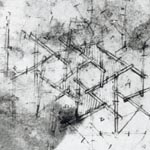Since the system is so simple, I could not imagine that it had not been invented before. The first names that came into my mind were Kenneth Snelson and Buckminster Fuller. In their work I found related drawings of patterns, however the constructions derived from them are all made from rods and wires (tensegrity). In the end I have found only one comparable source. On a page from one of the notebooks by Leonardo da Vinci, Codex Atlanticus f. 328 v-a, we find among others three patterns with exactly the properties of the bar grids defined above (see figures 7, 8, 9).



Figure 7: Pattern 1.
Figure 8: Pattern 2.
Figure 9: Pattern 3.
3. Spheres
In the domes it is gravity that keeps the loose rods together. It follows that continuing the construction as far as a complete sphere is not possible. Yet it turns out that using the above construction system objects can be formed where only the elements themselves, instead of gravity, keep the construction together. For example, we can assemble a sphere from a number of rods, or more generally elements, without using connecting materials like wire or glue. The number of connecting points per elements and the connecting rules do not change. It is only the form of the elements that changes. For a sphere we use curved rods instead of the straight rods for a dome.